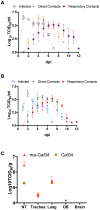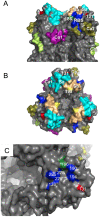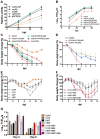Variations in the hemagglutinin of the 2009 H1N1 pandemic virus: potential for strains with altered virulence phenotype?
- PMID: 20976194
- PMCID: PMC2954835
- DOI: 10.1371/journal.ppat.1001145
Variations in the hemagglutinin of the 2009 H1N1 pandemic virus: potential for strains with altered virulence phenotype?
Abstract
A novel, swine-origin influenza H1N1 virus (H1N1pdm) caused the first pandemic of the 21st century. This pandemic, although efficient in transmission, is mild in virulence. This atypical mild pandemic season has raised concerns regarding the potential of this virus to acquire additional virulence markers either through further adaptation or possibly by immune pressure in the human host. Using the mouse model we generated, within a single round of infection with A/California/04/09/H1N1 (Ca/04), a virus lethal in mice--herein referred to as mouse-adapted Ca/04 (ma-Ca/04). Five amino acid substitutions were found in the genome of ma-Ca/04: 3 in HA (D131E, S186P and A198E), 1 in PA (E298K) and 1 in NP (D101G). Reverse genetics analyses of these mutations indicate that all five mutations from ma-Ca/04 contributed to the lethal phenotype; however, the D131E and S186P mutations--which are also found in the 1918 and seasonal H1N1 viruses-in HA alone were sufficient to confer virulence of Ca/04 in mice. HI assays against H1N1pdm demonstrate that the D131E and S186P mutations caused minor antigenic changes and, likely, affected receptor binding. The rapid selection of ma-Ca/04 in mice suggests that a virus containing this constellation of amino acids might have already been present in Ca/04, likely as minor quasispecies.
Conflict of interest statement
The authors have declared that no competing interests exist.
Figures




Similar articles
-
Antibody pressure by a human monoclonal antibody targeting the 2009 pandemic H1N1 virus hemagglutinin drives the emergence of a virus with increased virulence in mice.mBio. 2012 May 29;3(3):e00120-12. doi: 10.1128/mBio.00120-12. Print 2012. mBio. 2012. PMID: 22647789 Free PMC article.
-
Virulence-associated substitution D222G in the hemagglutinin of 2009 pandemic influenza A(H1N1) virus affects receptor binding.J Virol. 2010 Nov;84(22):11802-13. doi: 10.1128/JVI.01136-10. Epub 2010 Sep 15. J Virol. 2010. PMID: 20844044 Free PMC article.
-
Substitutions T200A and E227A in the hemagglutinin of pandemic 2009 influenza A virus increase lethality but decrease transmission.J Virol. 2013 Jun;87(11):6507-11. doi: 10.1128/JVI.00262-13. Epub 2013 Mar 27. J Virol. 2013. PMID: 23536663 Free PMC article.
-
[Advances in the structure and function of pandemic A/H1N1/2009 influenza virus HA protein].Bing Du Xue Bao. 2012 Jun;28(4):444-52. Bing Du Xue Bao. 2012. PMID: 22978172 Review. Chinese.
-
Pathogenesis of the 1918 pandemic influenza virus.PLoS Pathog. 2011 Jan 27;7(1):e1001218. doi: 10.1371/journal.ppat.1001218. PLoS Pathog. 2011. PMID: 21298032 Free PMC article. Review. No abstract available.
Cited by
-
Anti-hemagglutinin monomeric nanobody provides prophylactic immunity against H1 subtype influenza A viruses.PLoS One. 2024 Jul 10;19(7):e0301664. doi: 10.1371/journal.pone.0301664. eCollection 2024. PLoS One. 2024. PMID: 38985719 Free PMC article.
-
Genetic variations on 31 and 450 residues of influenza A nucleoprotein affect viral replication and translation.J Biomed Sci. 2020 Jan 6;27(1):17. doi: 10.1186/s12929-019-0612-z. J Biomed Sci. 2020. PMID: 31906961 Free PMC article.
-
The DBA.2 mouse is susceptible to disease following infection with a broad, but limited, range of influenza A and B viruses.J Virol. 2011 Dec;85(23):12825-9. doi: 10.1128/JVI.05930-11. Epub 2011 Sep 14. J Virol. 2011. PMID: 21917963 Free PMC article.
-
Differential Susceptibilities of Human Lung Primary Cells to H1N1 Influenza Viruses.J Virol. 2015 Dec;89(23):11935-44. doi: 10.1128/JVI.01792-15. Epub 2015 Sep 16. J Virol. 2015. PMID: 26378172 Free PMC article.
-
Genomic and protein structural maps of adaptive evolution of human influenza A virus to increased virulence in the mouse.PLoS One. 2011;6(6):e21740. doi: 10.1371/journal.pone.0021740. Epub 2011 Jun 30. PLoS One. 2011. PMID: 21738783 Free PMC article.
References
-
- Libster R, Bugna J, Coviello S, Hijano DR, Dunaiewsky M, et al. Pediatric hospitalizations associated with 2009 pandemic influenza A (H1N1) in Argentina. N Engl J Med. 2010;362:45–55. - PubMed
-
- Louie JK, Acosta M, Winter K, Jean C, Gavali S, et al. Factors associated with death or hospitalization due to pandemic 2009 influenza A(H1N1) infection in California. JAMA. 2009;302:1896–1902. - PubMed
-
- Hatta M, Gao P, Halfmann P, Kawaoka Y. Molecular basis for high virulence of Hong Kong H5N1 influenza A viruses. Science. 2001;293:1840–1842. - PubMed
Publication types
MeSH terms
Substances
Grants and funding
LinkOut - more resources
Full Text Sources
Other Literature Sources
Medical
Miscellaneous

